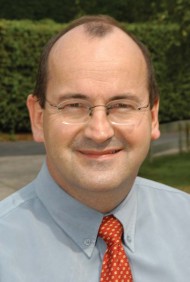 Structure-flex Ltd is a well-respected brand throughout industry, renowned for over 35 years for its expertise in supplying custom-made reinforced, flexible fabric products for indoor and outdoor use, made from heavy-duty, long-life thermoplastic materials.
Structure-flex Ltd is a well-respected brand throughout industry, renowned for over 35 years for its expertise in supplying custom-made reinforced, flexible fabric products for indoor and outdoor use, made from heavy-duty, long-life thermoplastic materials.
An approved supplier to the Ministry of Defence, Structure-flex supplies digitally printed curtains and banners for lorries; full colour advertising banners for racetracks and sporting events; dry bulk packaging for the petrochemical industry; flexible intermediate bulk packaging for food and pharmaceuticals applications; and woven bulk bags, bulk containers and polypropylene bags for general industrial use. Other markets Structure-flex currently operates in include large-sized fabric spheres, bulk liquid packaging, lifting and safety equipment and bespoke performance textile applications and graphic solutions.
Structure-flex has recently been seeing major growth in orders for its digitally printed curtains for curtain-sided commercial vehicles and trailers, for which it offers a fully vertically integrated print and production service supported by its factory in the Czech Republic. Ian Doughty, Managing Director of Structure-Flex, spoke to Warehouse & Logistics News.
Warehouse & Logistics News – When was Structure-flex set up and who by?
David Frankel founded Structure-flex in June 1970. The first product was the Big Bag, which we still produce today, a flexible bulk pack for the oil industry, made of PVC-coated reinforced polyester, measuring 1.5 m3 and with 2.5t capacity.
WLN – What happened to David?
He retired in 1992. I had been Managing Director since 1988, and led a management buyout.
WLN – What is your (Ian) role in the business day to day?
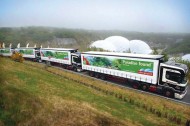 I‘m more Chairman than MD: I have other interests within the Resolute Corporate Holdings group, which take up much of my time. In Structure-Flex I’m actively involved in developing solutions for customers, as are my colleagues.
I‘m more Chairman than MD: I have other interests within the Resolute Corporate Holdings group, which take up much of my time. In Structure-Flex I’m actively involved in developing solutions for customers, as are my colleagues.
WLN – Who else is in the senior management team?
Our main operations person is Paul Reeve, the General Manager. He is a technical expert: the other key person is my son Matt Doughty, who is involved with sales and marketing.
WLN – How big is Structure-flex in turnover and employee numbers? How fast is it growing?
Structure-Flex has 42 staff and £4.5m turnover. We’re seeing 5-10% growth now, following a significant fall due to the recession in 2009.
WLN – Which are your biggest business areas?
Our biggest area tends to be our specialist products: we do a lot of development work resulting in innovative, bespoke products. Items we make frequently become commodity products. Our biggest category of ‘routine’ products in terms of units shipped is tension curtains for commercial vehicles. These are also our fastest growing area.
Structure-Flex has seen a large increase in supplying digitally printed lorry curtains, predominantly due to the superb value these offer customers in comparison to other forms of advertising. Following a strategic staged investment programme, we are vertically integrated from start to finish, and now offer a turnkey solution. We are able to design, print, lacquer, manufacture and fit curtains totally in-house, offering clients a single contact from start to finish. We can also print cab decals, as well as full rear door decals, if required.
WLN – How are you organised as a company to identify and meet the needs of industry for your products, in terms of lead generation and product design?
We’ve put considerable effort into our marketing, looking for new opportunities to innovate. We actively promote our capability to fabricate items to customers’ requirements. People regularly approach us with an outline idea or a prototype, asking ‘could you make this for us, but better?’ We’re looking to market this capability.
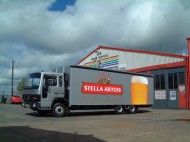 We also do a lot of market research to identify customers, for instance in the case of truck curtains, the food and drink companies, and then promote products to them.
We also do a lot of market research to identify customers, for instance in the case of truck curtains, the food and drink companies, and then promote products to them.
WLN – Who are the key customers within food and drink?
One particularly active area at present is brewing. The regional brewers are very interested in developing the visual images that go with their product, which gives us plenty of scope to develop partnerships with them. We work with their art houses to ensure they are developing their presentation to take full advantage of curtain technology and appreciate its potential.
WLN – How ‘flexible’ are you in the custom-made solutions you can provide for customers?
We have a range of systems we can use and tailor: in curtains, you can print a small image on a curtain, or print a whole curtain, or make a curtain with a decal. Alternatively, the cab can be coordinated with the client’s visual image.
We believe more people in the industry are alive to what’s possible now: the very high quality of products and extended lifespan mean more opportunities to see. The return on investment on a curtain is a very strong argument: digital print is winning people over.
WLN – Where do you engineer and fabricate your products?
All our engineering and graphic development is done in the UK, in conjunction with the client and their studio.
WLN – Do you supply any other countries besides the UK?
We don’t currently supply digital curtains overseas, though we have done so to the US and Middle East. With our other products a high proportion of orders are for export, to the US and Middle and Far East.
WLN – Do you work overseas directly or through agents?
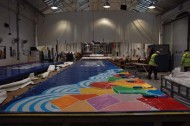 We work directly with end customers. Our overseas business generally comes through long-term relationships, some we’ve had for over 20 years.
We work directly with end customers. Our overseas business generally comes through long-term relationships, some we’ve had for over 20 years.
WLN – Which of your products are particularly aimed at the warehousing and logistics market?
At the distribution end, our key items are tension curtains and bulk packaging products: the truck curtains will probably be best known to your readers.
WLN – What dimensions do you make your digitally printed curtains to?
We can manufacture digitally printed curtains to any current vehicle dimension and any height and length, including step deck trailers.
WLN – What are your trailer curtains made of? How long do they last? Can they be easily repaired if damaged by lift trucks’ forks?
Digitally printed curtains utilise material specifically formulated to absorb the ink, while retaining the mechanical properties of standard curtain material. As always, life expectancy is directly linked to maintenance and damage, but digitally printed curtains should enjoy a similar life expectancy to traditional curtains. They can be repaired if damaged by fork lift trucks
WLN – What protection is offered against wear and tear, abrasion and UV?
The curtain print itself is protected by a ‘lacquer’, in which Structure-Flex has invested heavily. Most people pour lacquer on to the curtain from the tin, and use a ‘paint roller’ to spread it, which can leave an uneven distribution of lacquer and also potential for roller marks. The difference is, we apply lacquer by machine in a process we’ve perfected: our machine coats the whole surface consistently, leaving it blemish free. The lacquering provides the digital print with resistance against wear during use, protection against the elements and UV protection to discourage fading. Curtain construction techniques also ensure the digital print is not damaged by pelmet abrasion.
We’ve focused on consistency and reliability: we’ve automated printing and lacquer application so every curtain is repeatable to the same exact standard, and the colours and lacquer will still match, years on.
WLN – How long do digitally printed curtains last?
The lacquer manufacturers claim up to five years’ lifespan for the colour fastness and abrasive performance of the curtains in Northern Europe. At higher temperatures the substrate may degrade.
WLN – Does the buckle line interfere with the image?
Some people prefer the buckle line away from the image on the curtain: we’re happy for it either to be there or not. The buckle line is shown in the layout at the design stage, and the livery can be manipulated to avoid it if necessary. We are able to offer our Smoothside curtain system, which has no buckles on the face side, allowing for a full interrupted image from top to bottom for maximum impact.
WLN – What’s involved in the process of designing and supplying digitally printed curtains and banners?
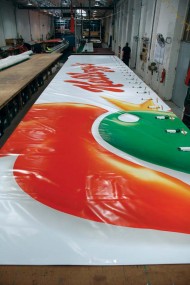 We have a wealth of experience in working with design houses, to ensure the livery is designed to fit the available space on the curtain first time, utilising simple templates. We also work with companies directly, in terms of designing layout options, using their existing livery or new artwork. A recent hardware and software upgrade ensures ease of the large size file manipulation, and the ability to work in the native imported file format.
We have a wealth of experience in working with design houses, to ensure the livery is designed to fit the available space on the curtain first time, utilising simple templates. We also work with companies directly, in terms of designing layout options, using their existing livery or new artwork. A recent hardware and software upgrade ensures ease of the large size file manipulation, and the ability to work in the native imported file format.
WLN – How long does it take from order to delivery? Do you supply and fit the curtains yourselves?
A typical lead-time from us viewing the artwork to fitting the initial pair of curtains is 3 to 4 weeks, with multiple pair orders completing over the following days depending on quantity. Repeat orders with pre-approved artwork complete far quicker. We are able to fit curtains, for those clients who require assistance.
WLN – Do you have partnerships with any particular truck and trailer suppliers to supply curtains?
No, we want to promote our proposition to the whole industry and make our own contacts with end users. Plain, ie non-printed, lorry curtains have become something of a commodity in the sector: for a printed curtain with significant investment in the quality of the imagery, rounded off by a good finish, you need a supplier who can deliver the right standard.
We use exactly the same base material as standard truck curtains, except that the finish can take digital printing. The process starts with a roll of material suitable for printing: we put the digital image on the base material in flat sheet roll form, print on it, lacquer it and fabricate it into a curtain.
WLN – What kinds of companies are the customers for your vehicle curtains?
End users include many blue chip brand leaders, as the pictures on these pages show. We supply soft drinks companies like Red Bull, Coca-Cola and Pepsi, pet foods companies like Pets At Home, DIY businesses like Howdens Joinery, fork lift suppliers like Toyota and industry suppliers in general who want to present their product in an attention grabbing way.
WLN – Do you carry out inspection and replacement of big fleets’ lorries’ curtains?
We can do it if invited – a number of companies have in-house fleet engineers and routine maintenance programmes. The bulk of curtain maintenance involves washing and cleaning, and tracking how vehicles are operated, just like non-digitally printed curtains. If needed, we can replace the existing print designs provided the artwork still exists.
WLN – What off the peg products do you supply?
We provide bulk bags and containers, polypropylene bags, lifting slings, load lashings and load retaining nets, all sourced in the UK. Everything else we supply is bespoke.
WLN – How do you go about producing custom-made fabric solutions for customers? What’s involved?
The most frequent starting point is a customer with an idea. We prototype it and develop it, including all necessary testing. We do the routine testing and certification ourselves on our bulk packaging products, so we know the parameters.
WLN – Can you talk about any of the ‘specials’ you’ve produced?
Probably our most memorable recent ‘special’ is the sphere we produced for SphereMania, an extreme sports customer, to enable people to get inside and roll down a hill in the sport of ‘sphereing’, these have been used in several TV adverts recently. The customer had developed it themselves and came to us to finish the job: we engineered it to achieve reliable performance and safety, and perfected it for them.
We also supply the MOD with portable, fabric-made water storage and distribution systems for military base camps around the world.
WLN – Do you produce customer case studies?
WLN – What lifting and safety equipment do you supply?
We supply lifting slings and safety harnesses. We acquired a company called Trans-Web (www.trans-web.co.uk) and moved Structure-Flex’s lifting sling business into it. Trans-Web is a sister company to Structure-Flex in the Resolute Corporate Holdings group.
WLN – How ‘green’ are your products?
Our products are PVC-coated, reinforced fabric in varying thickness and strengths. These last for up to 15 years and are frequently reused during that time, so in that sense they are not disposable unlike, say, the one-trip fabric bags used to transport stones for maintaining hill sides, which are often left behind.
WLN – What technical standards are your products made to?
We’re an ISO9000-registered firm and have quality assurance procedures in place. We make our lifting slings to BS standards: our bulk packaging is also certified to relevant BS standards, being tested and validated at accredited test houses in the UK and overseas.
WLN – Do you produce any temporary buildings or tents? Is this an area you are looking to develop?
We have produced a number of poultry tents for the agricultural industry, but nothing as yet for other applications, though we certainly have the capability.
WLN – What effect has the recession had on your business?
We saw a 20% downturn in 2009, which prompted corrective action to reduce our cost base, and with improved operating costs we returned to profit. We’re now experiencing growth, as I mentioned.
WLN – Finally, where do you see Structure-Flex Ltd going from here?
The nature of our work is innovating with new products and looking for novel applications and customers for them. This is an area we will continue to grasp with both hands. We have the technical team and resources to move forward, identifying fresh applications, looking for more unusual applications and providing new added value services.
Structure-Flex Ltd Tel: 01263 863100 www.structure-flex.co.uk




Comments are closed.